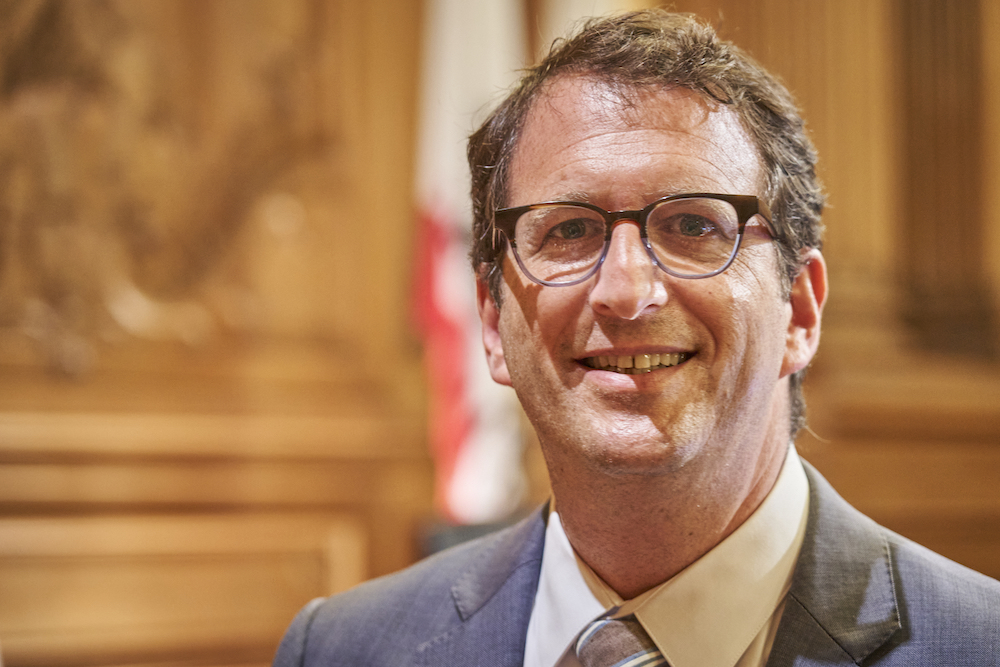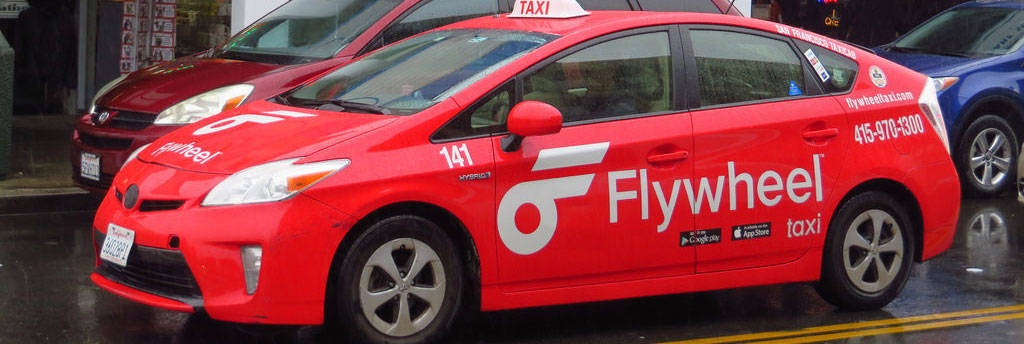Sup. Dean Preston plans to introduce legislation this week that would bar the mayor from requiring her appointees to sign undated resignation letters, a practice that Breed’s Office admits has happened on numerous occasions.
The proposal, which Preston announced on Twitter, comes in the wake of a great story by Michael Barba at the SF Standard exposing Breed’s demand that Police Commission Member Max Carter-Oberstone put such a letter on file.

The story also reveals a series of text messages between Breed’s staff and Carter-Oberstone showing how directly the mayor sought to influence the commissioner’s votes, positions, and public statements.
The fact that the mayor tries to tell her commission members how to vote, even in the middle of meetings, is not new. But these text messages show the extent to which Breed is willing to go to control the people who are supposedly independent members of an oversight panel.
Part of the back story here is that Carter-Oberstone didn’t support Breed’s choice for commission president and that he’s pushing to end “pretext stops” where cops pull someone over for a minor (or nonexistent) traffic violation and use that to conduct a search or hassle a driver.
The mayor wants to make sure the cops are good with any changes.
Carter-Oberstone is a lawyer with one of the biggest firms in the country, does not appear to be the least bit intimidated, and is continuing with his work on the commission.
We will see what Breed tries to do next.
Help us save local journalism!
Every tax-deductible donation helps us grow to cover the issues that mean the most to our community. Become a 48 Hills Hero and support the only daily progressive news source in the Bay Area.
The City Planning Commission is holding informational hearings Thursday/29 on two topics that will define the city’s future—and I don’t see how the panel can serious address either one unless the members decide to do what Carter-Oberstone did and defy the mayor.
The commission will likely have two more members by Thursday; the mayor appointed Derek Braun to the panel and reappointed Rachel Tanner, and both of those appointments go before the full board Tuesday/27. There’s no reason to believe both won’t be confirmed.
So the commission that hears presentations on Racial and Social Equity Planning and the upcoming Housing Element will be dominated by Breed appointees.
I don’t know what, if anything, she has ordered them to do or say.
But these are critical issues.
Let’s start with the racial and social equity program (although the two are tightly linked). The program goes back to 2020, and follows this commission resolution:
In the coming years the Department will amend the General Plan through adoption of updated Housing and Transportation Elements, adoption of a Preservation Element, and updates to incorporate environmental justice, racial and social equity, and climate resilience across all relevant elements. On May 28, 2020, the Department launched the first of these updates: the Housing Element 2022 Update. The Housing Element policies will be grounded on the following values: racial and social equity, minimum displacement, more housing for all in all neighborhoods, and neighborhoods resilient to climate and health crises. The Transportation Element will be the next Element to undergo an update and will center its policies in ConnectSF’s goals of equity, economic vitality, environmental sustainability, safety and livability, and accountability and engagement … the Planning Commission (Commission) adopted the Racial & Social Equity Action Plan, Phase I on November 21, 2019 to guide the Department and Commission actions to strengthen our internal-facing processes and practices to address disparities in the Department’s internal functions to advance organizational equity, through strategies that include: ongoing training for all staff; a biannual staff survey to assess Department attitudes and progress towards racial and social equity; and an interim Racial & Social Equity Assessment Tool to apply to relevant projects, policies, and practices. The Planning Commission adopted a Racial & Social Equity Vision on November 21, 2019, which envisions: inclusive neighborhoods that provide all with the opportunity to lead fulfilling, meaningful, and healthy lives; a city where public life and public spaces reflect the past, present and future of San Franciscans; a city where a person’s race does not determine their lives’ prospects and success; an inclusive Planning Department and Commissions that represent and engage the communities we serve; a Department that proactively infuses racial and social equity in both internal operations and external Planning work; and reimagines what the Planning field is and can be – inclusive, diverse and one that centers racial and social equity both as a practice and as an indicator of success.
The resolution directs the department
to center its work program and resource allocation on racial and social equity; acknowledges and apologizes for the history of racist, discriminatory and inequitable planning policies that have resulted in racial disparities; directs the Department to develop proactive strategies to address and redress structural and institutional racism, in collaboration with Black and American Indian communities and communities of color.
This is, of course, a massive, profound policy change, and the resolution acknowledges and apologizes for a long history of racism in SF planning.
The new approach has two elements: Improving diversity in hiring at the department, and putting racial and social justice at the forefront of future planning efforts.
I have no doubt the department is making every effort, and making progress, on recruiting, hiring, and promoting a more diverse staff.
But putting racial and social justice at the forefront of planning? That’s not possible when the department sees itself primarily as a permitting agency for private developers who seek to make the most money possible at the cost of the city’s remaining economic and racial diversity.
Take the project at 1010 Mission.
The planning staff, led by Director Rich Hillis, has guided this forward and recommended that the commission approve it. The project would have turned a parking lot in Soma (bad) into housing (good)—but 49 of the 57 units would have been tiny, expensive units suitable largely for single tech workers or others with high incomes and no kids.
The other eight would have been below-market-rate units suitable only for single people or couples with no kids.
The project would have been plopped in the middle of a low-income neighborhood threatened by gentrification and displacement.
From the Chron story by J.K. Dineen, who is an honest and principled reporter:
“As developers seek to maximize profit and the market-driven cost of development continues to rise, developers are proposing and building smaller and smaller units to increase their returns,” said David Woo of the SoMa Pilipinas Filipino Cultural District. “This should not be the guiding force of city planning.”
That’s exactly what the 2020 resolution says. And yet, planning staff wanted to see this project approved. The commission, missing two mayoral members, voted 3-2 to reject it.
The Chron’s editorial side is, of course, up in arms over that, saying that the city is ignoring state housing laws. Matthew Fleisher, the editorial page editor, is absolutely right: The city is ignoring the state’s housing laws. But he’s got it backward: The city has already approved far more market-rate housing than the state requires. The problem is that the affordable housing the state requires is never going to get built—not under this administration and planning department.
Susan Fainstein, the brilliant urban planning professor at Harvard, notes in her book “The Just City” that “equity is, by definition, redistributive.”
That is: Any real racial and social equity plan must take money and power from those who have it and give it to those who don’t.
I have never seen any proposal out of the City Planning Department, or out of this Mayor’s Office, that talks about taking large amounts of money, wealth, and power from the rich and giving it to the poor.
When community groups and some supervisors have tried to do that (as with Prop. C) the mayor opposed it.
What would a real equity plan look like? It would start with the idea that existing vulnerable communities are more important than developer profits, and that a lot of projects developers want should never even get to the commission unless they come with significant community benefits that outweigh their negative impacts. (Typically district supes have to negotiate those benefits after planning has already helped the developer move forward).
The state is negotiating with the city over its Housing Element, and the state wants a lot of changes. And the city planners are negotiating those changes.
But nowhere—nowhere—in any of the discussion is there any mention of the massive funding gap for the required affordable housing. Nor is there any serious discussion of a policy that would lead with the acquisition of existing buildings to take them out of the private market.
I wonder if the mayor’s appointees will even raise that question. Or maybe they have been told not to.
The meeting starts at 1pm.

The San Francisco MTA decided in April on a pilot policy to let Uber work with local cab companies to dispatch rides. In the process, the commissioners did two crucially important things that got very little notice at the time: They changed the way some cab fares are set, and they the linked the taxi industry with a company that has deeply damaged the city and whose stated goal is to destroy urban public transit.
The idea: Cab companies can offer set fares in advance, instead of relying on the meter, and Uber can now work with cab companies, including Flywheel, which has a competing app, to share dispatching.
In practice, an Uber customer who seeks a ride might be connected a regulated taxi, if the taxi driver is close by and decides to accept the ride, at the predetermined fare. That could mean more rides for regulated cabs.
Sue Vaughan, longtime environmental activist, says:
The SFMTA Board of Directors made this decision quickly and sloppily. The proposal had not been properly vetted by stakeholders including the Mayor’s Disability Council, the SFMTA Citizens Advisory Council, and the Paratransit Coordinating Council – let alone a variety of environmental and labor advocacy organizations.
Additionally, the SFMTA designated this giveaway to Uber not a “project” for the purposes of the California Environmental Quality Act – so no environmental evaluation was conducted. Had the proposal been subject to CEQA, members of the public could have appealed the approval.
The SF Taxi Workers Alliance is against the MTA’s approach, and the SF Labor Council passed a resolution that says:
To San Francisco taxi drivers, the taximeter rate represents a sacred trust with passengers that rates set through an open and transparent public process do not change from ride to ride, time to time, or passenger to passenger as determined by a secret algorithm, but apply at all times to all passengers equally … Uber’s business model is based on competition with public transportation (including locally regulated taxis) by pricing rides below cost and flooding the streets with cars, leading to increased congestion, declining Muni ridership, exacerbation of our global climate emergency, and impoverishment of taxi drivers, while exploiting and impoverishing its own drivers by taking larger and larger service fees from drivers.
The California Alliance for Retired Americans adds:
Our organization represents over 1 million Seniors and their families throughout California with a strong, well organized contingent residing in San Francisco. As such, we believe that empowering Uber to begin to take over the local taxi business, and set fares for all taxis dispatched through the Uber app, will negatively impact the needs of the people we represent. Many retired workers are seniors who do not have smartphones. They are elderly and depend on cab service for medical appointments, to run errands, and for outings.
Evelyn Engel, a board member of the Taxi Workers Alliance, told me that “it’s part of a global strategy by Uber to get taxi drivers on its platform. We are going into it without knowing what will happen and what drivers will earn.”
But Hansu Kim, who owns Flywheel Cab and who was a key player in the negotiations that lead to the new policy, told me that this is the best, and possibly the only, way to save the regulated cab industry in San Francisco: “This is only going to benefit taxis and taxi drivers, and you are going to see more taxis come onto the streets.”
There’s no question that the industry, thanks to Uber and Lyft, has suffered: Some 2,200 cabs—regulated by the city, with trained and well-screened professional drivers—used to work the streets of this city. Now, fewer than 1,000 cabs are on the road. Hundreds of people who borrowed money to buy taxi permits are suffering as their medallions have become worthless.
Before Uber, about 7,500 people had a license to drive a taxi; now, only 1,300 have an active card.
And it is, on the surface, more than odd that Kim would work with Uber; he’s sued the company in the past and consistently has blamed the illegal operations for clogging the streets and ruining the taxi industry.
On the other hand, he told me, the idea that people who use the Uber app could instead be directed to a nearby taxi creates a new customer base for a business that has been running out of customers.
Sup. Connie Chan has introduced a resolution calling on the MTA to rescind the third-party dispatch provision, keeping Uber (and potentially, Lyft) out of the business of setting cab fares, and potentially lessening (instead of expanding) the companies’ grip on local transportation. Her resolution states:
The third-party dispatch system would give TNCs the unfair advantage to continue to drive customers away from regulated taxis, and further give TNCs the ability to eliminate publicly regulated and transparent meter fares for taxis booked through third-party applications … SFMTA’s taxi meter rate setting process is a transparent, public process that leads to more predictable, stable meter rates that are often significantly more affordable to customers on average than those offered by TNCs; and SFMTA’s Taxi Upfront Fare Pilot Program relinquishes SFMTA’s charter-mandated authority to regulate taxi meter fares for all cab rides booked through third-party dispatch systems to TNCs, in particular to Uber and as a result, creates a monopoly.
That comes up for what will be a fascinating hearing, with potentially a lot of public input (something the MTA never had) on Thursday/29.
“I think the way this is going to work is misunderstood,” Kim told me. He will have his chance to explain it at the hearing, which begins at 10am.





